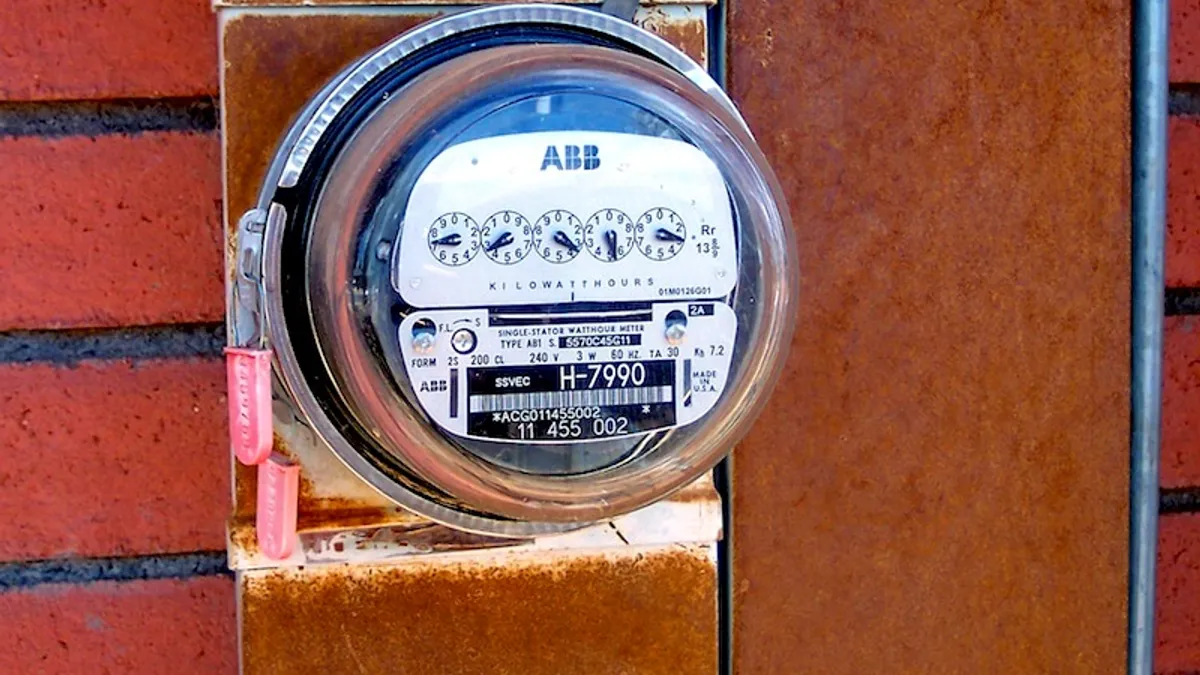Dive Brief:
- Most utilities are missing the opportunity offered by smart meters to help customers conserve energy, according to new research from the American Council for an Energy-Efficient Economy (ACEEE).
- ACEEE surveyed 52 utilities about their smart meter programs and six use cases, from time of use (TOU) rates to conservation voltage reduction (CVR). There are close to 100 million smart meters on the U.S. electric grid today, costing billions of dollars to install.
- Failure to optimize advanced metering infrastructure (AMI) investments could lead regulators to deny cost recovery and endanger future investments, experts say. Of utilities surveyed, ACEEE concluded only Portland General Electric uses smart meters to their fullest energy-saving capabilities.
Dive Insight:
Smart meter adoption rates have soared in the past decade and experts say the technology is foundational to broader grid modernization efforts, but ACEEE's survey finds utilities typically under-utilize the technology.
"Many utilities are underexploiting AMI capabilities and attendant benefits, thus missing a key tool to deliver value to their customers and systems," the report concludes. "This is due in part to organizational barriers including silos and workforce challenges, data access and sharing issues, and difficulties communicating the benefits and costs of AMI to key stakeholders."
The number of smart meters deployed by utilities in the United States reached about 98 million at the end of 2019, and according to the Edison Foundation Institute for Electric Innovation (IEI) will reach 107 million by the end of this year.
ACEEE's survey looked at how utilities are leveraging AMI, capturing data on six use cases: TOU rates, real-time energy use feedback for customers, behavior-based programs, data disaggregation, grid-interactive efficient buildings, and CVR or volt/VAR optimization.
Among utilities with 25% or greater smart meter penetration, ACEEE found behavior-based feedback and TOU rates were the most common programs offered.
Only Portland General Electric reported using AMI for all six of the surveyed use cases.
The utility first implemented smart meter programs almost a decade ago, and maintains a separate department that collects, stores and analyzes the data, and then shares it with its other divisions. Portland General has 888,000 smart meters on its system, according to recent data from IEI.
But other utilities, including some with much larger rollouts, are not getting full value from the devices, according to ACEEE. Florida Power & Light (FPL) has more than 5 million meters installed, but likewise only offers time-varying rates.
But there are use cases for AMI beyond energy efficiency, and FPL spokesperson Tyler Mauldin said the devices are returning dividends for customers.
"We have been using innovative technology for years to deliver reliable and affordable energy to our customers," Mauldin told Utility Dive. "We were among the first movers of smart meters and smart grid technology more than 10 years ago, and it is something we continue to look into."
In particular, FPL has used smart meters to assist with rapid service restoration during hurricanes, and has seen service reliability grow 30% in the past decade.
"It is definitely paying off for our customers," Mauldin said.
If utilities are not fully utilizing the meters, there is a risk that regulators will be hesitant to approve future grid modernization efforts, according to ACEEE program fellow and one of the report's authors Dan York.
"Failure to optimize AMI's potential for customer energy and cost savings can pose risks to utilities because these benefits are typically used to justify AMI investments," he wrote in a Jan. 9 blog post on the report's findings. "Regulators could deny cost recovery of such investments or not approve future investments proposed by utilities."
In 2019, regulators in Virginia rejected Dominion Energy's proposed smart meter rollout. Utility commissions in New Mexico, Massachusetts and Kentucky, have reached similar decisions.
"Most utilities are not maximizing the value of AMI," Navigant Research Analyst Michael Kelly told Utility Dive in an email. "What I would say though, is that the primary underutilization is coming from the use of AMI data ... not the devices themselves."
Data analytics is "still in its early stages among utilities," Kelly said. "AMI data, like other forms of grid sensor data, is relatively useless without advanced IT systems and data analytics solutions to process this data."
Correction: A previous version of this story incorrectly mischaracterized Southern California Edison’s usage of advance meters based on data featured in ACEEE’s report. Edison utilizes smart meters for all six of the use cases ACEEE analyzed, in addition to several others.















